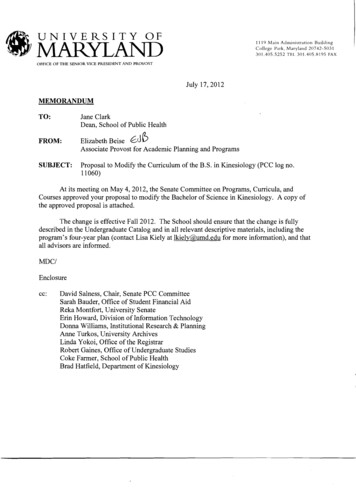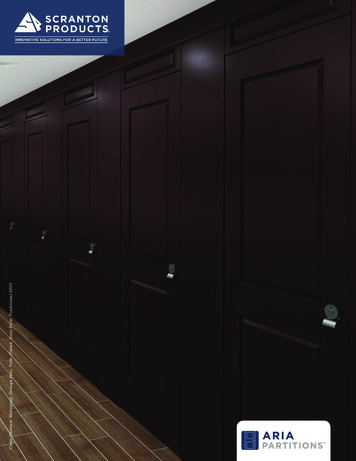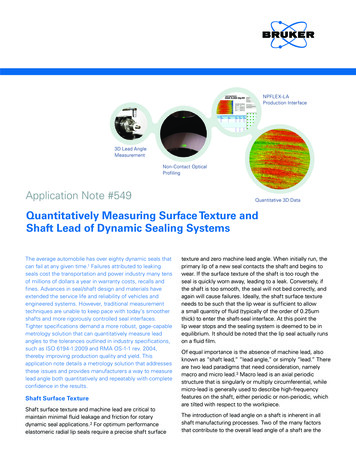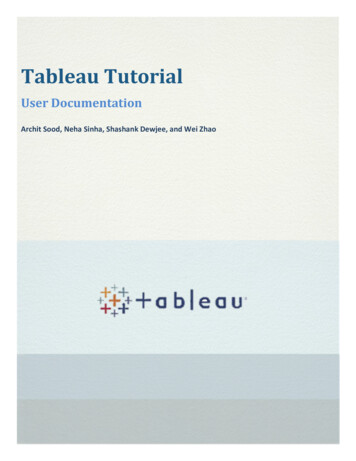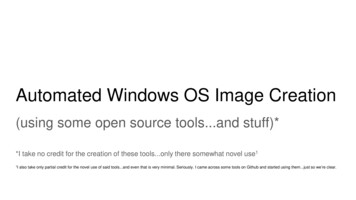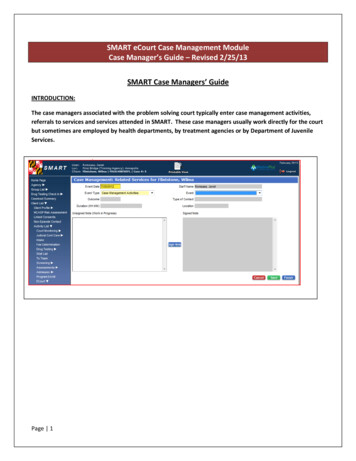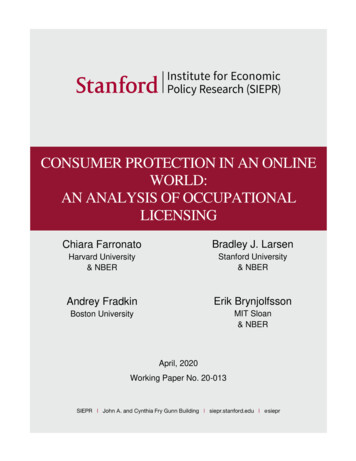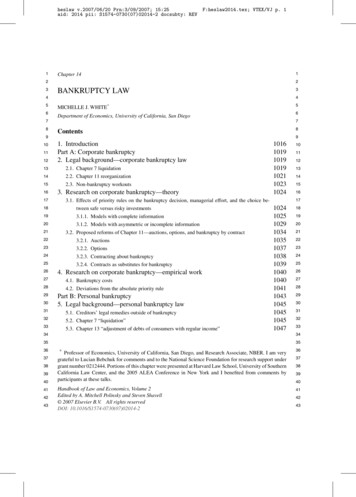
Transcription
Texture Pattern of Intensity and color.– Can be generalized to 3D texture. How do we get them?– Take pictures.– Write a program (procedural textures).– Synthesize from examples How do we apply them? (Texture mapping)– Specify a mapping from texture to object.– Interpolate as needed.– This can be a challenging problem, but we’ll considersimpler version.No TexturesImage courtesy, Foley, van Dam, Feiner, Hughes1
With TexturesImage courtesy, Foley, van Dam, Feiner, HughesvTexture Image1u01Courtesy, http://titan.spaceports.com/ seymor2
vProcedural Texture10v1uProcedural Texture7Assuming 3 bits:Uwave u % 207u3
vProcedural Texture7Assuming 3 bits:Vwave v % 20v7uProcedural Texture7Uwave u % 2Vwave v % 2Pix(u, v) Uwave Vwave07u4
Example Procedural ModelsImages from Texturing and Modeling: A Procedural ApproachBy Ebert, Musgrave, Peachey, Perlin, and WorleyExample Procedural ModelsImages from Texturing and Modeling: A Procedural ApproachBy Ebert, Musgrave, Peachey, Perlin, and Worley5
Example Procedural ModelsImages from Texturing and Modeling: A Procedural ApproachBy Ebert, Musgrave, Peachey, Perlin, and WorleyExample Procedural ModelsImages from Texturing and Modeling: A Procedural ApproachBy Ebert, Musgrave, Peachey, Perlin, and Worley6
Example Procedural TexturesImages from Texturing and Modeling: A Procedural ApproachBy Ebert, Musgrave, Peachey, Perlin, and WorleyWhat is Texture? Something that repeats (or continues, or hasstructure) with variation. Must separate what repeats and what staysthe same. Model as repeated trials of a random process– The probability distribution stays the same.– But each trial is different.– This may be true (eg., pile of objects) Can be added structure (general shape ofmountain, plus rocky variation).7
Perlin Noise Natural phenomenon derives its richness fromvariations But we don’t want white noise! Almost all movies use some form of Perlin noise:– James Cameron Movies (Abyss,Titanic,.)– Animated Movies (Lion King, Moses,.)– Arnold Movies (T2, True Lies, .)– Star Wars Episode I, Star Trek Movies– Batman Movies– Refer noisemachine.com for detailsPerlin Noise Reproducibility No repeatability Band limited (smoothlychanging) User control8
Strategy Generate smooth noise.– Generate noise with particular frequency Pick random values Interpolate to connect them smoothly.– Sum noise over many frequencies Map real numbers to intensity or color ininteresting way.––––Turn numbers into color.Distort numbers spatiallyTurbulenceNon-linear mappings.1D Perlin NoiseImage courtesy of Paul Bourke9
2D Perlin NoiseImages courtesy of Paul BourkeSmooth Noise1. Populate an integer grid with randomvalues.2. Interpolate in between to get values at noninteger points This creates a kind of smoothingAdvantages:1. Randomness at grid points2. Band limited10
Linear Interpolationf(x) floor(x)*(x-floor(x)) ceiling(x)*(ceiling(x)-x) Average of neighboring points weighted by distanceto them.Cubic InterpolationInstead of weighting by distance, d, weight by:1 – 3d2 2 d 3 Smooth Symmetric11
Suppose 0 x 1, and a function f is defined on f(0), f(1). We want todefine it for f(x) so that f(x) is smooth.If we do this by averaging neighbors, we have:f(x) g(x)*f(0) g(1-x)f(1). Then we want a function g that is smooth, andin which g(0) 1 and g(1) 0, and in which g is symmetric so that g(x) g(1-x) 1.With linear interpolation g(x) 1-x. This fits the second two criteria, butthis g is not smooth. There is a discontinuity at f(0), since we suddenlyswitch between averaging f(0) and f(1) and averaging f(0) and f(-1)So instead, we want f(x) near f(0) to be based mostly on the value of f(0),and only to gradually average in f(1) as we get closer to it.A nice function that does this is 1 – 3*d*d 2* d*d*d Note that g(1-x) 1 – 3*(1-x)(1-x) 2(1-x)(1-x)(1-x) 1 – 3 6x –3x*x 2 – 6x 6x*x – 2x*x*x 3x*x – 2*x*x*x 1 – (1 – 3x*x 2x*x*x)Gradient (Perlin) Noise Generate unit vectors (a, b) at each integerlattice point (ix, iy)– Use zero intensity at each lattice point.For a non-integer evaluation point (x, y)determine the 4 nearest integer grid points.For each integer grid point (ix, iy), find thefractional value of the vector (fx, fy) from (ix,iy) to (x, y, z) and take its dot product with thegradient vector at that integer point (ix, iy).Interpolate the 4 dot-product values tocompute the noise value at the grid pointThis has more high-frequency energy thanvalue noise.12
(www.noisemachine.com – Perlin)Multiple OctavesHow about if we introduce morefrequencies?double fractalsum(double x, double y, double z){double value 0;double f;for(f MINFREQ; f MAXFREQ; f * 2)value gnoise(x * f, y * f) / f;return(value);}Demo of assignment executable13
(www.noisemachine.com – Perlin)Fractsum 10 x 1014
Perlin Turbulencedouble turbulence(double x, double y, double z){double value 0;double f;for(f MINFREQ; f MAXFREQ; f * 2)value fabs(gnoise(x * f, y * f, z * f) / f);return(value);}(www.noisemachine.com – Perlin)15
Turbulence 10 x 10Spatial regularities Multiply intensities by sine of xcoordinates. DemoMap Intensities to ColorDemo16
(www.noisemachine.com – Perlin)Nonlinear changes in intensityBlue channel always 255, others takenfrom noise.17
3D Textures Can use to generate video Move through 2D slices ExampleSummary Smooth randomness.– More low frequencies than high.– Only low frequencies are kind of boring.– World seems to have such frequencies. User Control– Spatial and color variations.– Controls somewhat intuitive.18
OpenGL Texturing Create and specify a texture object– Create a texture object– Specify the texture image– Specify how texture has to be applied for each pixel Enable texture mapping Draw the textured polygons– Identify the active texture– Specify texture coordinates with verticesSpecify a 2D Texture Object glTexImage2D(GLenum target, GLint level, GLintinternalformat, GLsizei width, GLsizei height, GLintborder, GLenum format, GLenum type, const GLVoid*texels);– Eg: glTexImage2D(GL TEXTURE 2D, 0, GL RGBA, 128, 128,0, GL RGBA, GL UNSIGNED BYTE, image);– format and type used to specify the way the texels are stored– internalFormat specifies how OpenGL should store the datainternally– width and height have to be powers of 2; you can usegluScaleImage( ) to scale19
Specify how Texture is applied glTexParameter{if}(GLenum target, GLenum pname, TYPEparam) target can be: GL TEXTURE 1D, GL TEXTURE 2D, pnameparamGL TEXTURE WRAP SGL CLAMP, GL REPEATGL TEXTURE WRAP TGL CLAMP, GL REPEATGL TEXTURE MAG FILTERGL NEAREST, GL LINEARGL TEXTURE MIN FILTERGL NEAREST, GL LINEAREnable the Texture and Draw glEnable(GL TEXTURE 2D)– Enable 2D texturing glTexCoord2f(GL FLOAT u, GL FLOAT v)– Specify texture coordinates per vertex (justas normals, color, etc).– demo20
Create a Texture Object glGenTextures(GLsizei n, GLuint* textureIDs);– Returns n currently unused texture ID in textureIDs– Each texture ID is an integer greater than 0 glBindTexture(GLenum target, Gluint textureID);– target is GL TEXTURE 1D, GL TEXTURE 2D, orGL TEXTURE 3D– if textureID is being used for the first time a new texture object iscreated and assigned the ID textureID– if textureID has been used before, the texture object with ID textureID becomes activePutting it all togetherIn initialization:glGenTextures( );glBindTexture( );glTexParameteri( ); glTexParameteri( ); glTexImage2D( );glEnable(GL TEXTURE 2D);In display:glBindTexture( ); // Activate the texture defined ininitializationglBegin(GL TRIANGLES);glTexCoord2f( ); glVertex3f( );glTexCoord2f( ); glVertex3f( );glTexCoord2f( ); glVertex3f( );glEnd( );21
Texture SynthesisSynthesis as probabilisticmodeling Infer probability distribution for pixels Fill in pixel based on probabilitydistribution22
Simple Statistics Assume every pixel is independent Make new texture with same intensityprobabilities as old.– Example, if sample has 1/20 of pixels withintensity 117, then a pixel in new samplehas intensity 117 with probability 1/20.– DemoMarkov Model Pixels independent leads to white noise. Markov Model Captures localdependencies.– Each pixel depends on neighborhood. Example, 1D first order modelP(p1, p2, pn) P(p1)*P(p2 p1)*P(p3 p2,p1)* P(p1)*P(p2 p1)*P(p3 p2)*P(p4 p3)* 23
Markov model of Printed English From Shannon: “A mathematical theoryof communication.” Think of text as a 1D texture Choose next letter at random, based onprevious letters. Zero’th order:XFOML RXKHJFFJUJ ZLPWCFWKCYJFFJEYVKCQSGHYDQPAAMKBZAACIBZIHJQD24
Zero’th order:XFOML RXKHJFFJUJ ZLPWCFWKCYJFFJEYVKCQSGHYDQPAAMKBZAACIBZIHJQD First order:OCRO HLI RGWR NMIELWIS EU LLNBNESEBYA TH EEI ALHENHTTPAOOBTTVA NAH BRI First order:OCRO HLI RGWR NMIELWIS EU LLNBNESEBYA TH EEI ALHENHTTPAOOBTTVA NAH BRI Second orderON IE ANTSOUTINYS ARE TINCTORE T BE S DEAMY ACHIN DILONASIVE TUCOOWE ATTEASONARE FUSO TIZIN ANDYTOBE SEACE CTISBE25
Second orderON IE ANTSOUTINYS ARE TINCTORE T BE S DEAMY ACHIN DILONASIVE TUCOOWE ATTEASONARE FUSO TIZIN ANDYTOBE SEACE CTISBEThird order:IN NO IST LAT WHEY CRATICT FROUREBIRS GROCID PONDENOME OFDEMONSTURES OF THE REPTAGIN ISREGOACTIONA OF CRE. Zero’th order: XFOML RXKHJFFJUJZLPWCFWKCYJ FFJEYVKCQSGHYDQPAAMKBZAACIBZIHJQD First order: OCRO HLI RGWR NMIELWIS EULL NBNESEBYA TH EEI ALHENHTTPAOOBTTVA NAH BRI Second order ON IE ANTSOUTINYS ARE TINCTORE T BE S DEAMY ACHIN DILONASIVE TUCOOWE AT TEASONAREFUSO TIZIN ANDY TOBE SEACE CTISBE Third order: IN NO IST LAT WHEY CRATICTFROURE BIRS GROCID PONDENOME OFDEMONSTURES OF THE REPTAGIN ISREGOACTIONA OF CRE.26
I know that I shall meet my fateSomewhere among the clouds above;Those that I fight I do not hate,Those that I guard I do not love;My country henht is Kiltartan Cross,My countrymen Kiltartan's poor,No likely end could bring them lossOr leave them happier than before.27
Nor law, nor duty bade me fight,Nor public men, nor cheering crowds,A lonely impulse of delightDrove to rocid this tumult in the clouds;I balanced all, brought all to mind,The years to come seemed waste of breath,A waste of breath the years behindIn balance with this life, this death.28
Markov models of words First order:REPRESENTING AND SPEEDILY IS AN GOOD APTOR COME CAN DIFFERENT NATURAL HERE HETHE A IN CAME THE TO OF TO EXPERT GRAYCOME TO FURNISHES THE LINE MESSAGE HADBE THESE. Second order:THE HEAD AND IN FRONTAL ATTACK ON ANENGLISH WRITER THAT THE CHARACTER OFTHIS POINT IS THEREFORE ANOTHER METHODFOR THE LETTERS THAT THE TIME OF WHOEVER TOLD THE PROBLEM FOR ANUNEXPECTED.Same thing for pixels Each pixel depends on neighbors.1. As you synthesize, look at neighbors.2. Look for similar neighborhoods insample texture.3. Randomly choose one4. Copy pixel from that neighborhood.5. Continue.29
This is like copying, but not justrepetitionPhotoPattern Repeated30
With Blocks31
Summary Texture is made of structure andrandomness. Can get structure by providing knobs touser. Or from samples.32
THE HEAD AND IN FRONTAL ATTACK ON AN ENGLISH WRITER THAT THE CHARACTER OF THIS POINT IS THEREFORE ANOTHER METHOD FOR THE LETTERS THAT THE TIME OF WHO EVER TOLD THE PROBLEM FOR AN UNEXPECTED. Same thing for pixels Each pixel depends on neighbors. 1. As
